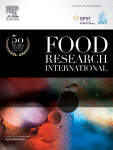Ver ítem
- xmlui.general.dspace_homeCentros Regionales y EEAsCentro Regional Santa FeEEA RafaelaArtículos científicosxmlui.ArtifactBrowser.ItemViewer.trail
- Inicio
- Centros Regionales y EEAs
- Centro Regional Santa Fe
- EEA Rafaela
- Artículos científicos
- Ver ítem
Effect of heat treatment and spray drying on lactobacilli viability and resistance to simulated gastrointestinal digestion
Resumen
Commercial probiotic bacteria are delivered mainly as frozen or freeze-dried cultures. However, spray drying is a lower cost technology that could be used for the production of probiotic cultures. In this work we aimed at screening among lactobacilli strains for candidates able to survive to spray drying and to study the effects of a preliminary mild heat treatment and different food matrices on post-drying survival and simulated gastric acid resistance.
[ver mas...]
Commercial probiotic bacteria are delivered mainly as frozen or freeze-dried cultures. However, spray drying is a lower cost technology that could be used for the production of probiotic cultures. In this work we aimed at screening among lactobacilli strains for candidates able to survive to spray drying and to study the effects of a preliminary mild heat treatment and different food matrices on post-drying survival and simulated gastric acid resistance. Heat resistance (survival to exposure at 60 °C for 5 min) in MRS broth or in 10% (wt/vol) skim milk was assessed in 22 strains of Lactobacillus casei, Lactobacillus paracasei, Lactobacillus acidophilus and Lactobacillus plantarum. Five strains (L. casei Nad, L. plantarum com, L. paracasei A13, L. plantarum 8329 and L. acidophilus A9) were selected for spray drying in 20% (wt/vol) skim milk and storage at 5, 25 or 37 °C for 75 days. For L.p. A13, L.p. com and L.a. A9 no differences in cell viability were observed due to spray drying. However, for L.c. Nad and L.p. 8329 cell death due to spray drying was 0.16 and 0.49 log orders CFU ml− 1 when a mild heat treatment (52 °C for 15 min) was applied and 0.85 and 0.95 log cycles, respectively, without preliminary mild heat treatment, showing that heat treatment enhanced survival to spray drying. The application of a heat treatment was effective for enhancing survival during storage of L.p. 8329, irrespective of the storage temperature and period. No significant cell loss at 5 and 25 °C was observed for L.c. Nad. For this strain, at 37 °C no cell counts of lactobacilli were observed after 30 days of storage. For L.a. A9, L.p. com and L.p. A13 a reduction in cell viability was observed along storage as temperature increased. Resistance to simulated gastrointestinal digestion was enhanced by spray drying. The application of a mild heat treatment before spray drying may enhance cell survival during storage and the resistance to gastrointestinal digestion. Spray drying might be used for enhancing cell functionality in a strain-dependant way.
[Cerrar]

Autor
Paez, Roxana Beatriz;
Lavari, Luisina;
Vinderola, Celso Gabriel;
Audero, Gabriela Maria;
Cuatrin, Alejandra;
Zaritzky, Noemi Elisabet;
Reinheimer, Jorge Alberto;
Fuente
Food Research International 48 (2) : 748-754 (October 2012)
Fecha
2012-10
Editorial
Elsevier
ISSN
0963-9969
Formato
pdf
Tipo de documento
artículo
Palabras Claves
Derechos de acceso
Restringido
 Excepto donde se diga explicitamente, este item se publica bajo la siguiente descripción: Creative Commons Attribution-NonCommercial-ShareAlike 2.5 Unported (CC BY-NC-SA 2.5)
Excepto donde se diga explicitamente, este item se publica bajo la siguiente descripción: Creative Commons Attribution-NonCommercial-ShareAlike 2.5 Unported (CC BY-NC-SA 2.5)

